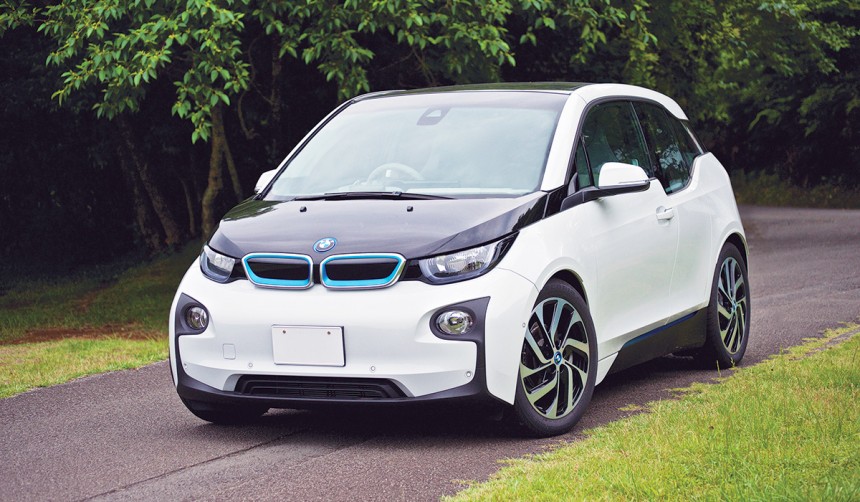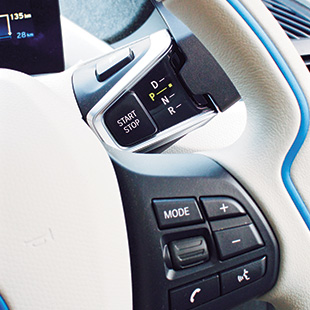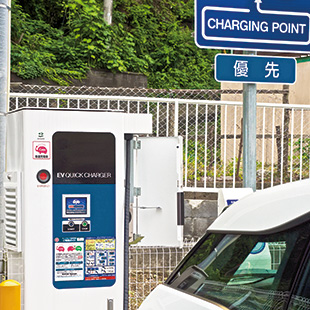
August 7, 2015
BMW’s Driver Electric
The car manufacturer’s i3 REx embraces the eco-friendly future
By Jack Beasley
The future is here: electric cars are now on the market and on the roads. In Japan, there are presently more e-car charging stations than gas stations. Is there an e-car in your future?
I just finished a one-month test of BMW’s i3 REx—yes, a one-month test—driving over 700 kilometers in the rain, wind, and sunshine. Almost every day, I drove the i3 to work and for pleasure, and really got to know this 100-percent electric car.
BMW has done about everything they could to keep this car as light as possible, from its thin tires to its entirely plastic and carbon-fiber body. Even the front seats were made thinner to cut down on poundage.

(Photo by Jack Beasley)
Why the weight loss? Better range for its all-electric power system, which is quite heavy. There is a small gas engine in the Range Extender (REx) model that activates from time to time to charge the battery for an extended range as you drive. You can get about 90 to 110 kilometers more when you get down to about five percent of the original power—then this engine kicks in. All in all, you’re looking at an around-190km/h range, if your driving habits are good.
OK, the car is light and has a good power plant. So how does it work as part of an everyday, everywhere, all-weather life?
I live in the hillsides of Izu, above 300 meters. During my test, each day started with a steep downhill drive and ended with a steep uphill one. Going down was a pleasure because the battery system on the i3 goes into a charging mode when not accelerating, and I could gain about five more kilometers of range for the drive. The reverse applies when going up, however; here, I lost seven to 10 kilometers of range for that charge.
The car’s home charging system requires a 220-volt electrical line, and since there is no 220-volt power in the homes out where I live, I had to rely on the quick 30-minute charging stations in Ito City. Using these stations, I was able to get 60-70 percent of a full charge, so stopping in there every other day was a must. It’s not the car’s fault, though. A bit of planning ahead is the answer if you don’t have 220 volts running in your home.

(Photo by Jack Beasley)
The inside of the car has oodles of room and windows everywhere—kind of like being in an aquarium. The front side windows are large and low, and there is no dead spot in the rear.
The i3 can be driven with only one pedal. When you take your foot off the accelerator, the car automatically applies the brake slowly, which can slow the car down to a stop if you don’t apply any pressure on the accelerator. Using this in traffic is extremely nice, once you get the hang of it. I liked it.
It also helps in curves since, as you lift your foot off the accelerator, the car brakes softly into the curve. This is called regenerative braking, and the key purpose is to extend battery life and range. Whenever the brakes are applied, the battery charges.
Smooth, smooth, and smooth is this i3: no noise, super-fast acceleration, and fun to drive. The only noise to be heard is when the gas-powered charging engine engages, which can be a bit loud—but this only kicks in from time to time, to extend range.

(Photo by Jack Beasley)
The doors are large for easy entrance and exit, and the back doors open outward and to the rear. However, you can only open the rear doors if the front doors are open and the folks in the front have their seat belts off, as they are attached to the back-door jams.
The i3 was designed to be a city car. However, I think I have proven it to be a vehicle that can be easily used in the small rural towns of Japan. With a 220-volt system at home for charging overnight and the plentiful quick-charging stations that increasingly dot the landscape—together with a little planning—you’ll be able to go 200 kilometers on a single charge.
As with any car, nothing is perfect—and getting used to a new car and its little differences takes a while. After a week of driving the i3, I had most of it under control and it became easier and more natural to use day by day. By the end of the month, I was driving like an i3 pro.
From its styling to its innovations, the BMW i3 is an unusual car—and also a real head-turner. While there are quibbles with a few design choices, it’s an excellent and eco-friendly option.
Are you ready for an e-car? I am!
Highlights
- Fast acceleration. 0 to 100km in 3.2 seconds. Fun, fun, fun!
- Quiet. Only a very soft road noise can be heard.
- Large interior. Seats are comfy and big, with lots of legroom in front.
- Easy Access. Back doors give a lot of space for accessing the interior.
- Navi. Fantastic nav system with program buttons and rotating center wheel.
- Quick Charging. Refill to a 60-percent charge in just 30 minutes.
- Quality. Extremely well-made. All the goodies you expect from BMW.







